Home Tags Posts tagged with "india elections 2014"
india elections 2014
Indian PM-elect Narendra Modi has received an enthusiastic welcome at his BJP party’s headquarters in Delhi after securing the most decisive election victory in three decades.
Narendra Modi was cheered by supporters after a victory parade from the airport.
Manmohan Singh, whose Congress party was crushed in the poll, has tendered his resignation as prime minister.
Narendra Modi, a Hindu nationalist and chief minister of Gujarat, campaigned on promises to revive the economy.
Results show the BJP gained a majority in parliament and will be able to govern without coalition partners.
However, many Indians still have profound concerns over Narendra Modi because of claims he did little to stop communal riots in Gujarat in 2002 in which at least 1,000 people died, most of them Muslims.
narendra Modi has always denied the allegations and was never charged.
After arriving in Delhi from his home state of Gujarat, Narendra Modi was greeted by flag-waving supporters. He stepped out of his car, flashing a victory sign.
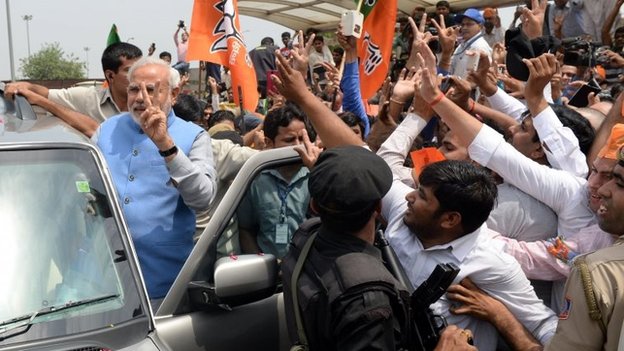
Narendra Modi was cheered by supporters after a victory parade from Delhi airport
A brass band, drummers and bagpipers met him at the BJP headquarters, while bunting and balloons decorated the street.
Narendra Modi will go to Varanasi for a ceremony by the river Ganges later on Saturday.
With votes still being counted, the BJP has won more than the 272 seats needed for a parliamentary majority.
With its allies, the party could get more than 330 seats out of 543.
Speaking at the BJP headquarters, Narendra Modi said: “I want to bow, I want to give my thanks… to the people of India.”
He said Indian media had created “consciousness among voters” and a “great festival of Indian democracy”.
On Friday, Narendra Modi wrote in a widely-shared tweet: “India has won, good days are about to come.”
He also told supporters he would rule for all Indians.
“The age of divisive politics has ended – from today onwards the politics of uniting people will begin.”
World leaders, including President Barack Obama and UK PM David Cameron, have congratulated Narendra Modi on his victory.
India’s new leader has received invitations to Washington and London. Previously, the US denied him visas and the UK cut off all ties with him following the 2002 riots.
Pakistani PM Nawaz Sharif commended the BJP’s “impressive victory” in the election.
The Congress party, which has dominated Indian politics since independence, is only expected to win 44 seats.
Congress has been mired in serious corruption scandals and its leadership has been considered ineffective in recent years, analysts say.
Accepting defeat, Congress President Sonia Gandhi said: “We humbly respect the verdict of the people.”
Manmohan Singh met the president to hand in his resignation.
In a televised farewell address earlier on Saturday, Manmohan Singh said the government had achieved a lot in the last 10 years.
“I wish the incoming government every success,” Manmohan Singh said.
[youtube JYc1y-nnlnY 650]
India’s opposition candidate Narendra Modi will be the next prime minister, with counting trends showing the pro-business Hindu nationalist and his party headed for the most resounding election victory the country has seen in thirty years.
The opposition Hindu nationalist BJP party has promised “good times ahead” as early results suggest it is on course for a landslide victory.
Narendra Modi’s landslide win was welcomed with a thundering rally on India’s stock markets and jubilant celebrations at offices across the country of his Bharatiya Janata Party (BJP), where supporters danced, exploded fireworks and handed out sweets.
Although final results are not expected until later, the scale of the predicted victory is such that the ruling Congress party has admitted defeat.

India’s opposition candidate Narendra Modi will be the next prime minister
BJP leader Narendra Modi tweeted: “India has won. Good times ahead.”
This is the most resounding victory for a political party in India for 30 years, say correspondents.
Narendra Modi, chief minister of the western state of Gujarat, is seen as a no-nonsense, can-do leader who stands for development and muscular nationalism.
He campaigned on promises of a revival in economic growth.
But many Indians still have profound concerns over Narendra Modi because of claims he did little to stop the 2002 communal riots in Gujarat, in which at least 1,000 people died, most of them Muslims – allegations he has always denied and over which he was never charged.
The election result will be a crushing blow to the Congress party, which is led by the Nehru-Gandhi family and has dominated Indian politics since independence.
It reflects voter anger with Congress, which has been mired in serious corruption scandals and whose leadership has been considered ineffective in recent years, analysts say.
India’s PM Manmohan Singh rang Narendra Modi to congratulate him on his victory.
Narendra Modi, 63, celebrated with a visit to his elderly mother in Gandhinagar, the state capital of Gujarat.
Latest election results showed the BJP is on course to win 278 seats, surpassing the 272 seats needed to secure a majority in the lower house of parliament.
With their allies, the party could achieve more than 300 seats.
Meanwhile, the Congress party – which has been in power for the past decade – is leading in fewer than 50 seats.
Accepting defeat, the Congress Party spokesman, Shakil Ahmed, said: “We are accepting the people’s verdict in all humility.
“Trends of the counting are certainly not in our favor. The trends point out that the country has decided to vote against us,” he was quoted by news agency AP as saying.
Even before the Congress party’s announcement, there were scenes of jubilation outside the BJP’s headquarters. Firecrackers exploded and people handed out sweets.
More than 500 million people voted in what is the world’s biggest exercise in democracy.
Voter turnout in the mammoth nine-phase general election was a record 66.38%, beating the previous 1984 poll record.
[youtube ZYeoR3nBhTw 650]
India is voting on the final day of the general election, with crowds turning out in the sacred city of Varanasi, a key battleground.
Opposition BJP leader Narendra Modi is being challenged in the seat by anti-corruption campaigner Arvind Kejriwal.
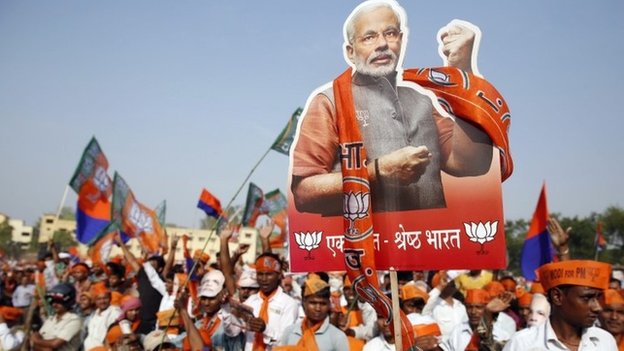
Opposition BJP leader Narendra Modi is being challenged in the seat by anti-corruption campaigner Arvind Kejriwal
Votes are also being cast in 40 other seats in Uttar Pradesh, Bihar and West Bengal states. The first exit polls are expected on Monday evening.
Narendra Modi is ahead in all the opinion polls. Votes will be counted on May 16.
India’s marathon election began on April 7 and has been held in nine phases for security and logistical reasons.
With 814 million eligible voters, it is the world’s biggest exercise in democracy and the governing Congress party is battling the opposition Bharatiya Janata Party (BJP) for power.
Varanasi has been the scene of frenzied political campaigning not seen in the ancient city in decades. The city been turned into a virtual fortress with thousands of police and paramilitaries deployed to ensure peaceful polling.
Narendra Modi is being given a spirited fight by Arvind Kejriwal of the Aam Aadmi Party, whose army of volunteers is engaged in extensive door-to-door campaigning.
There are a total of 42 candidates in the fray in the seat, including the Congress party’s Ajay Rai, a local political leader.
Correspondents say that this appears to be the most prestigious and high profile battle in the elections – top leaders from the BJP, Congress and AAP have all campaigned here for their candidates in the past weeks.
“This is a very politically conscious city. The epic battle between Mr. Modi and Mr. Kejriwal has pulled the city out of political oblivion,” says Dr. Vishwanath Pandey, who teaches at the Benares Hindu University.
The state of Uttar Pradesh, where Varanasi is located, returns more lawmakers than any other and is often described as India’s battleground state.
Varanasi, on the banks of the Ganges River, has long been neglected despite its religious significance and its infrastructure is badly in need of repair.
[youtube aVz27bLAm9Q 650]
Narendra Modi has been accused by India’s Election Commission of violating the election code.
India’s main opposition BJP’s prime ministerial candidate violated poll laws by flashing his party’s symbol and making a political speech while voting was going on in the seventh phase of the election, it said.
Narendra Modi addressed journalists and supporters after casting his vote in his home state of Gujarat.
He later posted a “selfie” of his inked finger on Twitter.
India’s general election, with 814 million eligible voters, is the world’s biggest exercise in democracy and the governing Congress party is battling the opposition Bharatiya Janata Party (BJP) for power. Narendra Modi is ahead in all the opinion polls.
He was greeted by cheering crowds lining the streets and on rooftops as he arrived at the polling station in Ahmedabad, Gujarat’s biggest city. Voting was held in all 26 seats in the state.
Andhra Pradesh also voted on Wednesday for the last time as a united state before it is divided on June 2.
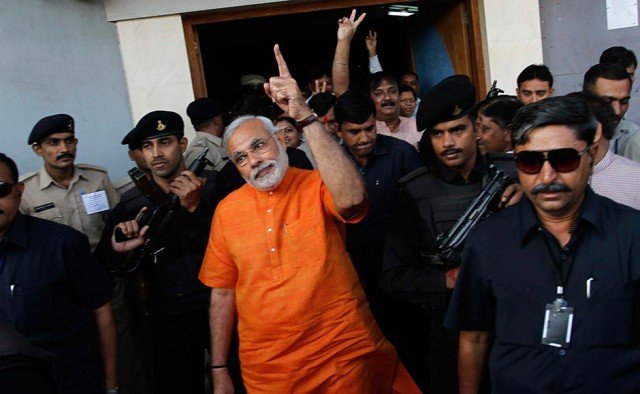
Narendra Modi has been accused by India’s Election Commission of violating the election code
Gujarat and Andhra Pradesh were among seven states and two union territories where 139 million eligible voters had to make their choice between some 1,300 candidates contesting 89 seats on Wednesday.
“The BJP will form a stable government in Delhi soon,” Narendra Modi said after casting his vote.
“The Congress party has already conceded defeat… It is the end of the mother-son government,” he added, in a reference to the Congress party chief Sonia Gandhi and her son Rahul.
But photographs of an upbeat Narendra Modi holding a small white lotus flower, shown on television screens across India, have landed him in trouble with the Election Commission.
The commission said it had seen the video recordings of Narendra Modi’s speech and that it was evident that it was “a political speech intended and calculated to influence and affect the result of elections in the constituencies voting today”. It has now ordered the authorities to register a case against him.
A spokesperson for the BJP said Narendra Modi had done nothing wrong and that the party would respond to the Election Commission notice.
If found guilty, Narendra Modi could be sent to jail for up to two years or asked to pay a fine, or both, but correspondents say it is unlikely to happen.
Narendra Modi is standing for election in two seats – in the Hindu holy city of Varanasi as well as Vadodara in Gujarat. If he wins both seats, he will have to relinquish one.
In Andhra Pradesh – where voting for state assemblies is also taking place – brisk polling was reported through the day.
In Hyderabad city, scores of people complained that their names were missing from the voters’ list and in some polling centers electronic voting machines did not work.
The 17 parliamentary constituencies in Andhra Pradesh going to the polls on Wednesday are to be part of the newly-created state of Telangana.
Voting for the remaining 25 parliamentary seats which will constitute Andhra Pradesh after the state is split in two will be held on May 7.
The marathon general election, which began on April 7, will conclude on May 12. Votes will be counted on May 16.
[youtube axEi-_Nhf00 650]
[youtube w0Hcs0ItTlk 650]
Bharatiya Janata Party’s leader Narendra Modi, the man with the biggest chances of winning India’s elections, is to submit his election nomination papers as Indians vote in the sixth phase of their poll.
Narendra Modi arrived in the holy city of Varanasi as supporters from BJP poured onto the streets.
Varanasi will be the scene of an epic battle between Narendra Modi and anti-corruption campaigner Arvind Kejriwal, who is challenging him there.
There are 117 seats up for grabs on Thursday, but Varanasi votes on May 12.
The ruling Congress party is battling the opposition BJP to win the votes of the 814 million Indians eligible to vote.
About 2,000 candidates are hoping to win over 180 million of those votes as polling takes place in West Bengal, Uttar Pradesh, Madhya Pradesh, Bihar and Indian-administered Kashmir on Thursday.
The southern state of Tamil Nadu, where voting is being held in all 39 seats on Thursday, is a key battleground to watch.
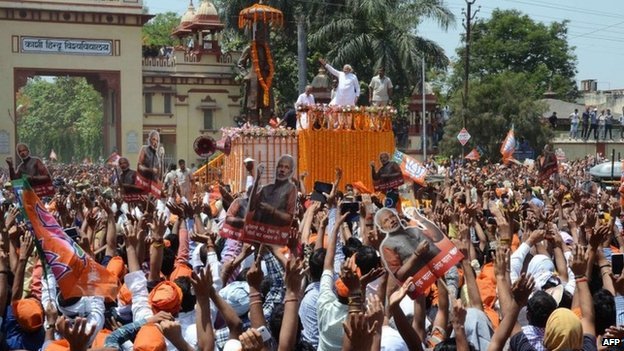
Narendra Modi arrived in the holy city of Varanasi as supporters from BJP poured onto the streets (photo AFP)
More than 35% of votes had been polled by 11:00 local time.
The main contest is between two powerful regional parties – the ruling AIADMK and the main opposition DMK. The two main national parties are fringe players in the state and have traditionally formed alliances in order to ensure power.
India’s financial capital, Mumbai, is also voting on Thursday in what promises to be a keenly-contested battle between two alliances: the ruling Congress-Nationalist Congress Party alliance against a resurgent BJP-Shiv Sena party.
Mumbai usually doesn’t see very high turnouts – it was just over 41% in the 2009 election – but many here say this time things might be different.
In an area where many Bollywood actors live, superstar Aamir Khan has already cast his vote, while Shahrukh Khan is expected to do so in the afternoon.
The marathon vote is being staggered over five weeks for security and logistical reasons. The nine-phase vote began on April 7 and will conclude on May 12. Votes will be counted on May 16.
The main contest in the election is between the Congress, led by Rahul Gandhi, and the BJP, led by the charismatic and controversial Hindu nationalist leader Narendra Modi.
Narendra Modi, who is ahead in all the pre-election opinion polls, is the leader of Gujarat state, which witnessed one of India’s worst anti-Muslim riots in 2002.
Arvind Kejriwal, contesting against Narendra Modi in Varanasi is at the helm of the anti-corruption Aam Aadmi (Common Man’s) Party, which secured a spectacular result in local polls in Delhi last year and offers a challenge to the main parties.
Several smaller regional parties are also in the fray and if no single party wins a clear majority, they could play a crucial role in the formation of a government.
Any party or a coalition needs a minimum of 272 lawmakers to form a government.
[youtube uaboMb0luEc 650]
India is voting in the biggest day of the general election pitting the ruling Congress party against the main opposition BJP.
Polling takes place in 121 seats in 12 states, including the key states of Karnataka, Rajasthan, Uttar Pradesh, Bihar, Maharashtra and West Bengal.
The nine-phase vote began on April 7 and will conclude on May 12. Votes will be counted on May 16.
More than 814 million Indians are eligible to vote in the polls.
Polling has been already completed in 111 seats, and voter turnout in most states has been higher than in 2009.
April 17 is one of the most critical days of voting spread across 12 states, from Indian-administered Kashmir in the north, to the information-technology hub of Bangalore in the south, Rajasthan in the west and the tea-growing Himalayan town of Darjeeling in the east.
With all of its 28 seats going to polls on Thursday, the southern state of Karnataka is a key battleground.
Bangalore South is one of the keenly contested seats in the state with Congress party’s Nandan Nilekani, BJP’s Ananth Kumar and the Aam Aadmi Party’s (AAP) Nina Nayak as candidates.
Nandan Nilekani is the billionaire co-founder and former CEO of Infosys, one of India’s largest IT services firms, while Ananth Kumar is a former federal minister.
The anti-corruption Aam Aadmi (Common Man’s) Party, which secured a spectacular result in local polls in Delhi last year, offers a challenge to the main parties.
Several smaller regional parties are also in the fray and if no single party wins a clear majority, they could play a crucial role in the formation of a government.
Thousands of police and paramilitary security personnel have been deployed across the country to ensure smooth polling.

India is voting in the biggest day of the general election pitting the ruling Congress party against the main opposition BJP
The marathon vote is being staggered over five weeks for security and logistical reasons.
The main contest in the elections is between the Congress, led by Rahul Gandhi, and the BJP, led by the charismatic and controversial Hindu nationalist leader Narendra Modi.
Narendra Modi, who is ahead in all the pre-election opinion polls, is the leader of Gujarat state, which witnessed one of India’s worst anti-Muslim riots in 2002.
The BJP has promised to improve the economy and infrastructure and curb corruption if it wins in the general elections.
The Congress party has promised “inclusive growth” if it returns to power, with a raft of welfare schemes, including a right to healthcare for all and pensions for the elderly and disabled.
Any party or a coalition needs a minimum of 272 lawmakers to form a government.
Dates when different states and Union Territories vote:
Andaman and Nicobar islands: April 10
Andhra Pradesh: April 30 and May 7
Arunachal Pradesh: April 9
Assam: April 7, 12 and 24
Bihar: April 10, 17, 24, 30, May 7 and 12
Chandigarh: April 10
Chhattisgarh: April 10, 17, 24
Dadra and Nagar Haveli: April 30
Daman and Diu: April 30
Delhi: April 10
Goa: April 17
Gujarat: April 30
Haryana: April 10
Himachal Pradesh: May 7
Jammu and Kashmir: April 10, 17, 24, 30 and May 7
Jharkhand: April 10, 17, 24
Karnataka: April 17
Kerala: April 10
Lakshadeep: April 10
Madhya Pradesh: April 10, 17, 24
Maharashtra: April 10, 17, 24
Manipur: April 9, 17
Meghalaya: April 9
Mizoram: April 9
Nagaland: April 9
Odisha: April 10, 17
Puducherry: April 24
Punjab: April 30
Rajasthan: April 17 and 24
Sikkim: April 12
Tamil Nadu: April 24
Tripura: April 7, 12
Uttarakhand: May 7
Uttar Pradesh: April 10, 17, 24, 30, May 7 and 12
West Bengal: April 17, 24, 30, May 7 and 12
[youtube hJYquPYXxk4 650]
At least 12 people have been killed in the eastern Indian state of Chhattisgarh by two bombs planted by suspected Maoist rebels as voting continues in the general election.
The first blast hit a bus carrying election officials in Bijapur district, police said, killing seven.
The second attack – half an hour later – killed five police in an ambulance in the Bastar district.
India began five weeks of general election polling last Monday.
Officials said the bus in Bijapur district was blown up by a landmine as it travelled between Gudma and the town of Kutru. Four people were injured.
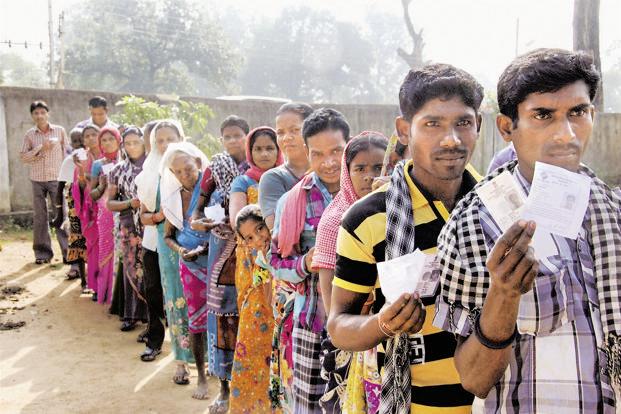
Polling began in part of in Chhattisgarh on April 10 and continues with two further rounds in the coming weeks
Several people were also injured in the separate attack on the ambulance, which took place in the village of Kamanar, election officials said.
Maoist rebels have staged frequent attacks over several decades across a swathe of India in their campaign for the poor to have a greater share of India’s natural resources.
Chhattisgarh has seen some of the worst violence. Polling began in part of the state on April 10 and continues with two further rounds in the coming weeks.
Elsewhere, voting resumed in the fourth stage of the general election on Saturday in four states – Goa, Assam, Tripura and Sikkim.
Sikkim, a tiny Himalayan state, is also holding local elections, including the contest for a seat in the regional assembly which is reserved for a Buddhist monk.
The first key day of polling saw millions of Indians vote on Thursday in 14 states.
The governing Congress party, led by Rahul Gandhi, is pitted against the main opposition BJP, led by the Hindu nationalist, Narendra Modi.
However, the anti-corruption Aam Aadmi (Common Man’s) Party, with its stronghold in the capital, Delhi, is mounting a strong challenge.
More than 814 million Indians are eligible to vote in the polls, which opened on April 7.
Indians are voting on the first big day of the general election pitting the ruling Congress party against the main opposition BJP.
Polling is being held in 91 seats in 14 states, including in the capital Delhi and the key states of Uttar Pradesh, Kerala, Maharashtra and Orissa.
The nine-phase vote began on Monday, April 7, and will conclude on May 12. Votes will be counted on May 16.
More than 814 million Indians are eligible to vote in the polls.
Two soldiers were killed and three others injured in a landmine explosion blamed on Maoist rebels in Jamui, a rebel stronghold in the eastern state of Bihar, police said.
The blast occurred before polling began, but voting has remained unaffected in the area.
Voters have turned out enthusiastically to cast their ballots in the politically crucial northern state of Uttar Pradesh which sends the maximum number of lawmakers to the parliament.
Some 16 million voters are eligible to cast their ballots in 10 constituencies in the state that go the polls today.
They include the restive Muzaffarnagar constituency, where at least 65 people were killed and 51,000 people – mostly Muslims – were displaced after Hindu-Muslim clashes in September.
Voters at a school in the Sarvapriya Vihar district began queuing as polling opened at 07:00.
Soon, several dozen people had queued up to cast their votes and the lines were getting longer by the minute.
Officials checked their names on the list and put the indelible ink on their forefingers.

Indians are voting on the first big day of the general election pitting the ruling Congress party against the main opposition BJP
The anti-corruption Aam Aadmi (Common Man’s) Party, which secured a spectacular result in local polls in Delhi last year, offers a challenge to the main parties.
Several smaller regional parties are also in the fray and if no single party wins a clear majority, they could play a crucial role in the formation of a government.
The marathon vote is being staggered over five weeks for security and logistical reasons.
Thousands of police and paramilitary security personnel have been deployed to ensure polling passes off peacefully.
On the first day of voting on April 7, polling took place in six constituencies in two states in the north-east – five in Assam and one in Tripura.
In the second phase on Wednesday, voting was held in six seats across four states.
The Lok Sabha (lower house of parliament) has 543 elected seats and any party or a coalition needs a minimum of 272 lawmakers to form a government.
The main contest in the elections is between the Congress, led by Rahul Gandhi, the latest member of India’s influential Nehru-Gandhi dynasty, and the BJP, led by the charismatic and controversial Hindu nationalist leader Narendra Modi.
Narendra Modi, who is ahead in all the pre-election opinion polls, is the leader of Gujarat state, which witnessed one of India’s worst anti-Muslim riots in 2002.
The BJP has promised to improve the economy and infrastructure and curb corruption if it wins in the general elections.
The party launched its manifesto hours after polling began for the first phase.
The Congress party has promised “inclusive growth” if it returns to power.
In its election manifesto, the party promised a raft of welfare schemes, including a right to healthcare for all and pensions for the elderly and disabled.
India polling days:
April 7 – 2 states, 6 constituencies
April 9 – 5 states, 7 constituencies
April 10 – 14 states, 91 constituencies
April 12 – 4 states, 7 constituencies
April 17 – 12 states, 121 constituencies
April 24 – 12 states, 117 constituencies
April 30 – 9 states, 89 constituencies
May 7 – 7 states, 64 constituencies
May 12 – 3 states, 41 constituencies
Counting of votes – May 16
[youtube A-W4vU00DOY 650]
[youtube wB1ZRkWJYSw 650]
India has begun voting in the world’s biggest election, with the nine-phase ballot beginning on Monday and concluding on May 12.
India ruling Congress party pitted against the Hindu nationalist BJP opposition.
Votes will be counted on 16 May.
More than 800 million Indians are eligible to vote in a poll dominated by corruption and high inflation.
A new anti-corruption party, the AAP, is also contesting the elections after a spectacular result in local polls.
The AAP (Aam Aadmi, or Common Man’s Party) made a strong showing at the state assembly polls in the capital, Delhi, and is standing for all the seats in the parliament.
Several smaller regional parties are also in the fray and if no single party wins a clear majority, they could play a crucial role in government formation.
The Lok Sabha (lower house of parliament) has 543 elected seats and any party or a coalition needs a minimum of 272 lawmakers to form a government.
PM Manmohan Singh has already said he is stepping down and the Congress is being led by Rahul Gandhi, the latest member of India’s influential Nehru-Gandhi dynasty.

India has begun voting in the world’s biggest election (photo AP)
The BJP is being led by the charismatic and controversial Hindu nationalist leader Narendra Modi.
Narendra Modi, who is ahead in all the pre-election surveys, is the leader of Gujarat state, which witnessed one of India’s worst anti-Muslim riots in 2002.
Some 814 million voters – 100 million more than at the last elections in 2009 – are eligible to vote at 930,000 polling stations, up from 830,000 polling stations in 2009.
Electronic voting machines will be used and will, for the first time, contain a None of the Above (Nota) button – an option for voters who do not want to cast their ballot for any of the candidates.
On the first day of voting, polling is taking place in 6 constituencies in two states in the north-east – five in Assam and one in Tripura.
The first voters have already cast their ballots in the state, with many others queuing up outside polling stations.
Assam is a Congress party stronghold but the opposition BJP is hoping to make inroads.
The Congress party has promised “inclusive growth” if it returns to power.
In its election manifesto, the party has promised a raft of welfare schemes, including a right to healthcare for all and pensions for the aged and disabled.
The BJP has yet to come out with its manifesto but in his election speeches across the country, Narendra Modi has promised economic development, jobs for the youth and a corruption-free government.
India’s polling days:
- April 7 – 2 states, 6 constituencies
- April 9 – 5 states, 7 constituencies
- April 10 – 14 states, 92 constituencies
- April 12 – 3 states, 5 constituencies
- April 17 – 13 states, 142 constituencies
- April 24 – 12 states, 117 constituencies
- April 30 – 9 states, 89 constituencies
- May 7 – 7 states, 64 constituencies
- May 12 – 3 states, 41 constituencies
- Counting of votes – May 16
Election Commission of India
[youtube eAUZV7hAV_A 650]
[youtube DK-zet_VZW0 650]
India’s Election Commission has announced the country’s general election will take place in nine phases in April and May.
Polling to elect a new Lok Sabha, or lower house, will be held from April 7 to May 12. Votes will be counted on May 16.
With some 814 million eligible voters, India’s election will be the largest the world has seen.
The ruling Congress party and the main opposition Bharatiya Janata Party will be battling a host of smaller parties.
Leaders of 11 regional parties have formed a Third Front against the Congress and the BJP.
A new anti-corruption Aam Aadmi (Common Man’s) Party (AAP), which made a spectacular debut in recent polls in the capital Delhi, will also contest the elections.
If no single party wins a clear majority, smaller parties could play a crucial role.
India’s lower house has 543 elected seats and any party or a coalition needs a minimum of 272 MPs to form a government.
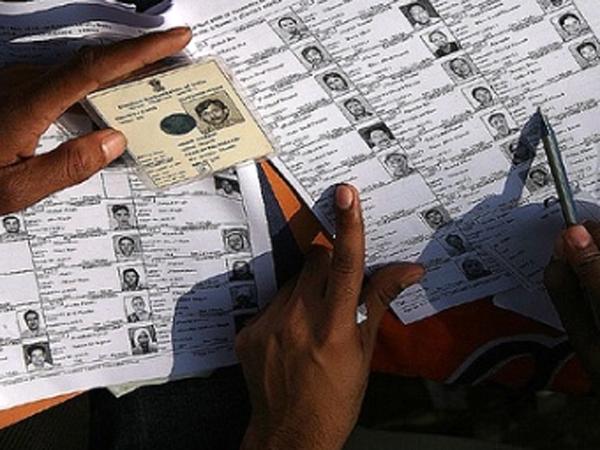
India’s Election Commission has announced the country’s general election will take place in nine phases in April and May
Some states will hold polls in several phases. The new parliament has to be constituted by May 31.
Chief Election Commissioner VS Sampath said school examination schedules, weather and crop harvesting seasons had been taken into account in deciding the polling dates.
Some 814 million voters – 100 million more than the last elections in 2009 – are eligible to vote at 930,000 polling stations, up from 830,000 polling stations in 2009.
Electronic voting machines will be used and will contain a None of the Above (NOTA) button, an option for voters who do not want to cast their ballot for any of the candidates.
Elections in the states of Uttar Pradesh and Bihar will take place in six phases. Kashmir and West Bengal will vote in five phases each.
Uttar Pradesh is India’s most populous states and one of its largest. Elections in the capital, Delhi, will be held on 10 April.
The polls are being seen as a straight contest between the governing coalition led by the Congress party and the opposition BJP which is being led by the charismatic and controversial Hindu nationalist leader, Narendra Modi.
Narendra Modi, who is ahead in all the pre-poll surveys, is the leader of Gujarat state which witnessed one of India’s worst anti-Muslim riots in 2002.
Incumbent PM Manmohan Singh is stepping down and Congress is being led by Rahul Gandhi, the latest member of India’s influential Nehru-Gandhi dynasty.
India’s polling dates:
- April 7 – 2 states, 6 constituencies
- April 9 – 5 states, 7 constituencies
- April 10 – 14 states, 92 constituencies
- April 12 – 3 states, 5 constituencies
- April 17 – 13 states, 142 constituencies
- April 24 – 12 states, 117 constituencies
- April 30 – 9 states, 89 constituencies
- May 7 – 7 states, 64 constituencies
- May 12 – 3 states, 41 constituencies
- May 16 – Counting of votes [youtube GTbLhfkDMMc 650]










